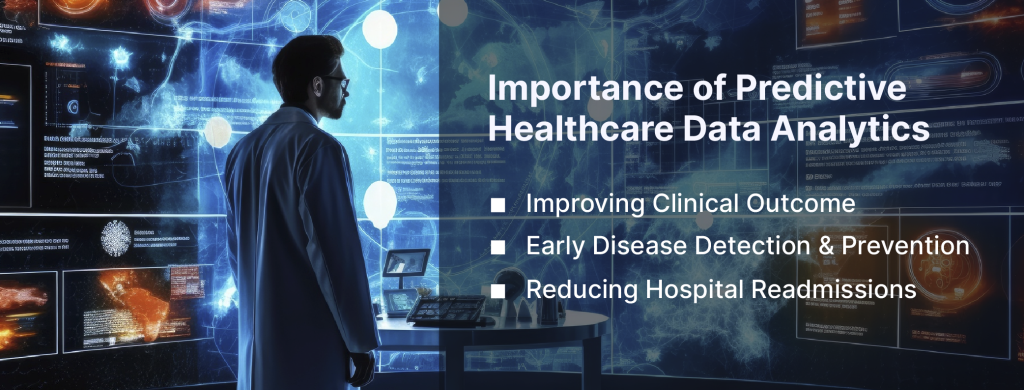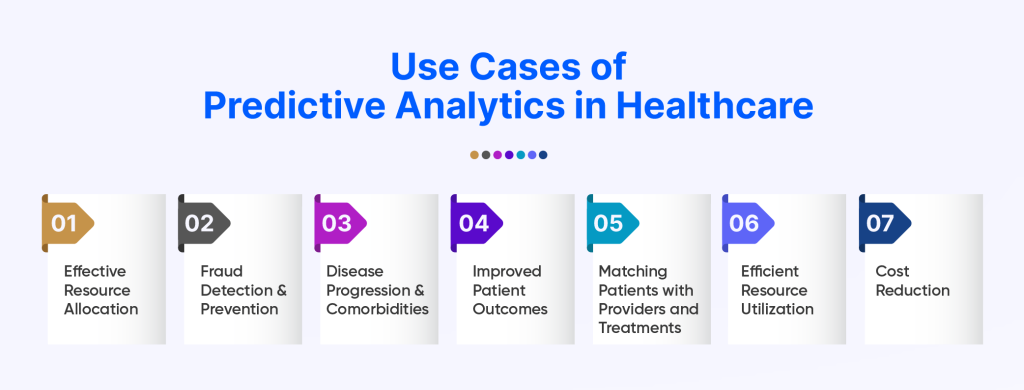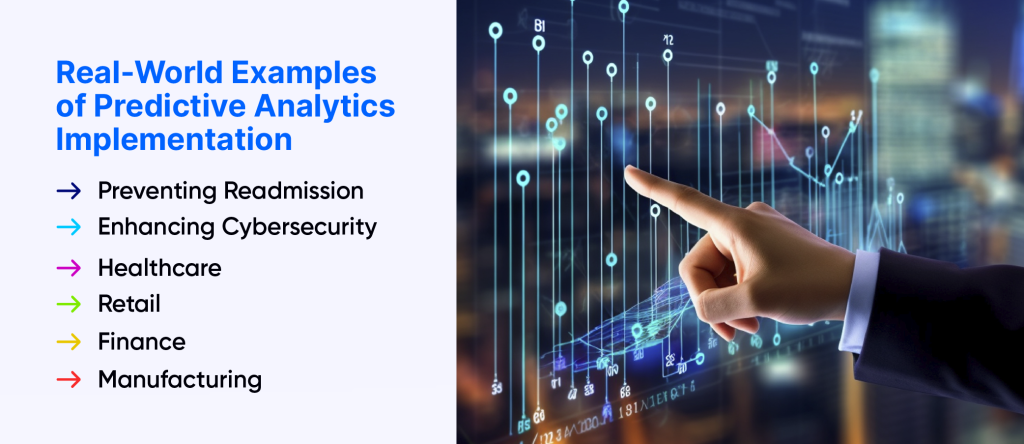When teams operate independently, it creates communication gaps that can lead to disorder. In contrast, when teams collaborate, they tend to be more efficient.
Big data has affected every business, including healthcare and retail. Predictive analytics has been made possible by this abundance of data, enabling contemporary businesses to make insightful decisions and precise future projections.
Predictive analytics has emerged as a transformative force in various industries, and its impact on healthcare is particularly profound. At its core, predictive analytics involves the use of statistical algorithms and machine learning techniques to analyze historical and real-time data, uncover patterns, and forecast future events or trends. In the context of healthcare, this methodology enables healthcare professionals to anticipate patient outcomes, optimize resource allocation, and enhance overall decision-making processes.
Predictive analytics is a tool used in the healthcare industry to forecast future health trends, anticipate patient requirements, and improve operational efficiency by analyzing both historical and real-time data. Big data is ingested by predictive analytics systems from many healthcare ecosystem data sources, including insurance and administrative records, electronic health records (EHR), and other data sources.
To provide fresh insights, this kind of advanced analytics makes use of statistical modeling, data mining, and machine learning. These insights can be used by healthcare companies to manage chronic diseases and reduce readmission rates to hospitals.
The importance of predictive analytics in healthcare cannot be overstated, as it serves as a pivotal tool in revolutionizing the industry by enhancing patient care, resource management, and overall operational efficiency. Better risk estimations for cardiovascular disease can be obtained by predictive analytics that leverages social and environmental patient data, as demonstrated by recent studies. Clinicians can stop at-risk patients from experiencing worsening symptoms that might require hospitalization by using these insights.
Predictive analytics helps healthcare providers address staffing shortages and maximize capacity management from an operational perspective. 94% of registered nurses in their area indicate that there is a moderate to severe shortage of nurses, and eighty percent predict that the shortfall will worsen in the next five years. Hospitals can more effectively use their resources by using predictive analytics to enhance staff scheduling. Several key aspects underscore the significance of predictive data analytics in the healthcare sector:

Predictive analytics enables healthcare providers to identify potential health risks and predict disease onset before symptoms manifest. By analyzing patient data and recognizing patterns, healthcare professionals can intervene early, facilitating proactive measures for prevention and early intervention. Healthcare predictive analytics leverages advanced algorithms and data analysis techniques to forecast future health outcomes, identify high-risk patients, and optimize healthcare delivery.
Predictive analytics healthcare technology WellSky CareInsights helps home healthcare providers observe reduced hospitalization rates and improved service efficiency. Over a three-year period, providers who used the tool daily saw a 45% decrease in visits per admission and a 26% decrease in hospitalization rates.
Using predictive analytics, UnityPoint Health, a network of clinics, hospitals, and home care providers, decreased readmissions by 40% in just 18 months. In one instance, a doctor employed predictive analytics to determine that the patient’s symptoms will probably return in 13 to 18 days. The doctor therefore recommended the patient to get in touch with the practice at that time. The doctor changed the patient’s prescription right away when the symptoms reappeared, saving the patient from being readmitted. Predictive models help identify patients at a higher risk of readmission, allowing healthcare providers to implement targeted interventions and post-discharge care plans. This proactive approach reduces the likelihood of readmissions, improving both patient outcomes and healthcare resource utilization. Moreover, AI chatbots in healthcare leverage natural language processing and machine learning algorithms to provide personalized and efficient patient support, appointment scheduling, medication reminders, and symptom triage.
The benefits of data analytics in healthcare are manifold. Predictive analytics models provide several advantages over traditional approaches, including lower readmission rates and better patient outcomes.

A vital advantage for any healthcare facility experiencing a staffing shortfall is that efficient resource allocation helps providers minimize burnout and make sure they’re operating at full capacity. For instance, the Gundersen Health System increased room utilization by 9% through the use of artificial intelligence-powered predictive analytics.
Predictive analytics can analyze claims data to identify unusual patterns that may indicate fraudulent activities, such as billing for services not rendered or upcoding. By detecting fraudulent behavior early, healthcare organizations can save significant costs and maintain the integrity of their operations.
Similar to this, according to Adam Wilcox, director of Washington University School of Medicine’s Center for Applied Clinical Informatics and member of the American Medical Informatics Association, healthcare organizations are employing predictive analytics to identify patients whose diseases might worsen. For example, they can use it to forecast which diabetic patients have a higher risk of developing kidney disease. Predictive analytics is another tool used by clinicians to spot patients whose symptoms are getting closer to sepsis. According to Wilcox, it’s a vitally important skill that has the potential to save lives because it makes early interventions possible, which can significantly improve the prognosis for these individuals.
By analyzing vast amounts of health data, predictive analytics can identify patients at high risk of developing certain conditions, enabling early intervention and more personalized care plans. Data analytics in the healthcare industry has transformed the way patient data is analyzed and utilized to improve treatment outcomes and optimize care delivery.
Predictive analytics technologies that have access to extensive patient data can match patients with doctors who have the training and expertise necessary to address their illness. Predictive models can also examine a patient’s past medical records to assist doctors in developing a customized treatment strategy.
Healthcare facilities can use predictive analytics to forecast patient inflows and manage their resources more efficiently, reducing wait times and improving patient satisfaction.
By predicting potential health crises and avoiding unnecessary hospitalizations or procedures, predictive analytics can significantly reduce healthcare costs.
Predictive analytics is a powerful tool that businesses across various industries leverage to anticipate future trends, understand customer behavior, and make data-driven decisions.
80% of healthcare administrators state that the use of advanced analytics in support of decision-making is “negligible,” despite the fact that 95% of physician groups and hospitals have access to such tools. One explanation is a lack of knowledge about the advantages that advanced analytics bring to the healthcare organization and the community. Predictive analytics in healthcare examples demonstrate how advanced data analysis techniques can forecast patient readmissions and prioritize resources for chronic disease management.
Here are a few real-world examples demonstrating how predictive analytics is implemented in different sectors:

Hospital readmissions come at a hefty cost. Readmissions cost the US healthcare system about $52.4 billion annually. In addition, Medicare’s Hospital Readmission Reduction Program, which offers financial incentives to prevent readmissions, imposes severe penalties on hospitals. 82% of the hospitals in this program experienced this kind of penalty, according to studies.
Healthcare hacks are common, according to the HIPAA Healthcare Data Breach Report. As per the data, there were approximately 82.6 million compromised healthcare records between January and October 2023, with hacking being the most frequent cause of these incidents. In real-time, risk scores for various online transactions may be computed by healthcare companies using artificial intelligence systems in conjunction with predictive analytics. The scores can then be used to inform incident response.
Retail companies use predictive analytics to forecast demand, optimize inventory levels, and personalize shopping experiences. By analyzing historical sales data, customer preferences, and market trends, retailers can predict which products will be popular in the upcoming season, tailor their marketing strategies to individual customers, and ensure that they have the right amount of stock to meet demand.
In the healthcare sector, predictive analytics helps in improving patient care and reducing costs. By analyzing patient data, medical history, and treatment outcomes, healthcare providers can identify patients at high risk of developing certain conditions, offer preventive measures, and optimize treatment plans. This proactive approach not only enhances patient outcomes but also reduces unnecessary hospital admissions and treatments. AI predictive analytics in healthcare utilizes machine learning algorithms and advanced data analysis to forecast patient outcomes, optimize treatment plans, and enhance operational efficiency.
Financial institutions use predictive analytics for risk assessment, fraud detection, and customer segmentation. By analyzing transaction data, market trends, and customer behavior, banks can identify potential fraud, assess the creditworthiness of borrowers, and offer personalized financial products. This not only mitigates risk but also enhances customer satisfaction and loyalty.
In manufacturing, predictive analytics is used for predictive maintenance and optimizing production processes. By monitoring equipment data and performance metrics, manufacturers can predict when a machine is likely to fail and perform maintenance beforehand, reducing downtime and maintenance costs. Additionally, by analyzing production data, they can identify inefficiencies and optimize their processes for better productivity and quality.
There are numerous moving components in healthcare services, from insurance to patient care. Additionally, the data is dispersed among a number of systems and gadgets, including imaging equipment, remote patient monitoring devices, EHRs, etc. Because of this, integrating data is a difficult task for healthcare companies. To ensure that only high-quality data is being ingested by predictive models, data professionals must guide the data through the integration process.
It’s also critical to note that the data used to train predictive analytics systems sets limits on their capabilities. As demonstrated by the machine learning models that predicted COVID-19 patient outcomes, historical data can be utilized to create accurate predictions about the future, but there is no assurance that these forecasts will always be true.
IntellicoWorks is revolutionizing patient care with its cutting-edge AI development services, setting new benchmarks in healthcare efficiency and patient satisfaction. By harnessing the power of artificial intelligence, we enable healthcare providers to deliver personalized, proactive, and predictive care, ensuring that every patient receives the attention and treatment they deserve.
With AI development services, healthcare facilities can leverage advanced algorithms and machine learning models to analyze vast amounts of data, uncovering valuable insights about patient health trends and treatment outcomes. This data-driven approach allows for the early detection of potential health issues, personalized treatment plans, and optimized resource allocation, all of which contribute to superior patient care. Whether it’s through predictive analytics, intelligent diagnostics, or automated patient monitoring, IntellicoWorks’ AI development services are at the forefront of healthcare innovation.
From 2023 to 2030, the global predictive analytics in healthcare market, estimated at $11.7 billion in 2022, is projected to expand at a compound annual growth rate (CAGR) of 24.4%. Both health tech firms and healthcare providers can benefit greatly from it. As a manager of a medical facility, look for ways to implement predictive analytics within your company and make sure executives and physicians are on board. Make sure the algorithms you create as the creator of a health tech firm are equitable and appropriate for the demographic groups you are targeting.
Revolutionize Your Operations with Customized AI Development Services!

Talk to us and let’s build something great together
A Subsidiary of Vaival Technologies, LLC
IntelliCoworks is a leading DevOps, SecOps and DataOps service provider and specializes in delivering tailored solutions using the latest technologies to serve various industries. Our DevOps engineers help companies with the endless process of securing both data and operations.
Ops
Cloud
AI & ML
Copyrights © 2023 byIntellicoworks. All rights reserved.